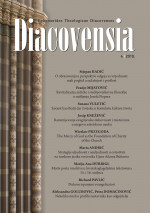Motiv posta i molitve u hrvatskoglagoljskim tekstovima 15. i 16. stoljeća
The Motif of Fasting and Prayer in Selected Croatian Glagolitic Texts of the 15th and 16th
Author(s): Marija-Ana DürriglSubject(s): Christian Theology and Religion, Historical Linguistics, South Slavic Languages, 15th Century, 16th Century, Philology
Published by: Katolički bogoslovni fakultet u Đakovu
Keywords: fasting and prayer as a literary motif; Middle Ages; Early Modern age; Croatian Glagolitic literature; Oxford Miscellany; Berčić Miscellany; Gršković Miscellany;
Summary/Abstract: The Croatian Glagolitic medieval literature consisted mostly of religious texts (e.g. hagiographies, visions, debates/contrasts, Miracles of the Blessed Virgin, dialogue poems, miracle and morality plays). Some of them contain the motif of fasting and prayer as well as the benefits of self-renunciation, allowing men to become purer and better in their relationships towards both themselves (through fasting and self-renunciation) and other people (through good deeds and almsgiving), and to achieve a closer relationship with God (through prayer). The motif of fasting and prayer is frequently found in texts of various themes, forms, and genres over the centuries. It was present in European Christian literature from its beginnings to the early modern period, making it a long-standing motif. During the Middle Ages in Europe, that motif was most notably found in moral-didactic and pastoral texts, but also in narrative prose texts. Three Croatian Glagolitic manuscript codices were chosen for this research: Oxford Miscellany (15th c.), Berčić Miscellany (15th c.) and Gršković Miscellany (16th c.), as collections of texts exhibiting motifs of fasting, prayer and works of mercy. The recombination of the motif in different contexts (as a sermon in a debate, as a motif in a legend and as a starting point of a moral-didactic text) reflects the memory-based nature of medieval culture – that which is adopted as one’s own, can be recombined rather freely. The three Glagolitic codices list Biblical figures and saints who found salvation from evil through fasting and prayer (e.g. Isaac, Lot, Susanna, Daniel, three young men in the fiery furnace, Saint Thecla, and Saint Margaret) and those in various ways blessed by God (e.g. Moses, Elijah, Joachim and Anne, the apostle Paul, Saint Nicholas, Saint Benedict). The list of characters is consistent to a large extent in all three manuscripts. The tone and style of the texts indicate that they were intended not only for a smaller religious community, but also for a wider audience. Two important features of Croatian Glagolitic prose are present in the analysed texts: polyfunctionality, because the texts combine practical (e.g. pastoral, moral and didactic) functions with the aesthetic function; and the openness of the form, because themes, motifs and images always appear in new combinations and contexts.
Journal: Diacovensia: teološki prilozi
- Issue Year: 27/2019
- Issue No: 4
- Page Range: 671-687
- Page Count: 17
- Language: Croatian

